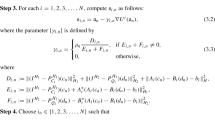Abstract
An infeasible method of large-system optimization is proposed. The dual gap is resolved by use of the generalized Lagrangian as in the previous methods due to Stephanopouloset al. and Watanabeet al. The values of subsystem inputs are, however, coordinated in the second level, instead of being adjusted in the first level, as in previous methods. As a result, in contrast with previous methods, the subproblems in the first level include a small number of variables to be adjusted; in addition, the generalized Lagrangian is decomposable in a simple manner. Further, the decomposition is not subject to any restriction, which is often encountered in feasible methods.
Similar content being viewed by others
References
Lasdon, L. S.,Optimization Theory for Large Systems, The Macmillan Company, New York, New York, 1970.
Bertsekas, D. P.,Multiplier Methods: A Survey, Automatica, Vol. 12, pp. 135–145, 1976.
Stephanopoulos, G., andWesterberg, A. W.,The Use of Hestenes' Method of Multipliers to Resolve Dual Gaps in Engineering Systems Optimization, Journal of Optimization Theory and Applications, Vol. 15, No. 3, 1975.
Watanabe, N., Nishimura, Y., andMatsubara, M.,Decomposition in Large Systems Optimization Using the Method of Multipliers, Journal of Optimization Theory and Applications (to appear).
Brosilow, C., Lasdon, L. S., andPearson, J. D.,Feasible Optimization Method for Interconnected Systems, Proceeding of the Sixth Joint Automatic Control Conference, Troy, New York, 1965.
Umeda, T., Shindo, A., andTazaki, E.,Optimal Design of Chemical Process by Feasible Decomposition Method, Industrial and Engineering Chemistry, Process Design and Development, Vol. 11, No. 1, 1972.
Bauman, E. J.,Multilevel Optimization Techniques with Application to Trajectory Decomposition, Advances in Control Systems, Vol. 6, Edited by C. T. Leondes, Academic Press, New York, New York, 1968.
Miele, A., Moseley, P. E., Levy, A. V., andCoggins, G. M.,On the Method of Multipliers for Mathematical Programming Problems, Journal of Optimization Theory and Applications, Vol. 10, No. 1, 1972.
Denn, M. M., andAris, R.,Green's Functions and Optimal Systems, Industrial and Engineering Chemistry Fundamentals, Vol. 4, No. 3, 1965.
Dixon, L. C. W.,The Safeguarded Cubic Technique, The Hatfield Polytechnic, Numerical Optimization Centre, Technical Report No. 4, 1969.
Fletcher, R., andPowell, M. J. D.,A Rapidly Convergent Descent Method for Minimization, Computer Journal, Vol. 6, No. 2, 1963.
Author information
Authors and Affiliations
Additional information
Communicated by D. G. Luenberger
The authors would like to acknowledge the valuable comments given by Professor D. G. Luenberger of Stanford University, Stanford, California.
Rights and permissions
About this article
Cite this article
Watanabe, N., Matsubara, M. An infeasible method of large-system optimization by direct coordination of subsystem inputs. J Optim Theory Appl 24, 437–448 (1978). https://doi.org/10.1007/BF00932887
Issue Date:
DOI: https://doi.org/10.1007/BF00932887




